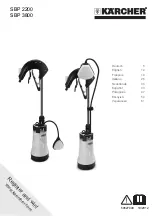
V-HEAT SERIES · AIR/WATER SYSTEM
© ASTRALPOOL 2018. ALL RIGHTS RESERVED. CONFIDENTIAL AND PROPRIETARY DOCUMENT.
Page 32 of 72
ENGLISH
Refrigerant Gas Charge:
The equipment uses R407C class refrigerant. The gas taken from the refrigerant bottle must be introduced in the low-
pressure circuit by means of a charger (expansion system).
After having discharged the cooling circuit, and after having installed the charger and connected the flexible tubes of the
gauge to the high and low-pressure circuits, we can proceed with the charge:
1.- High and low pressure switches
2.- Low pressure circuit (blue).
3.- Vacuum pipe/ gas charge (yellow).
4.- Low pressure circuit (red).
5.- R407C gas (yellow).
6.- High pressure valve (on the machine).
7.- Low pressure valve(on the machine).
A. Connect the main line of the gauge to the R407C bottle stopcock.
B. Open the bottle stopcock and purge the section of tubing.
C. Open the high-pressure valve.
D. Pressurise the equipment to equal the pressure of the bottle.
E. Close all gauge valves.
F. Start the machine. The low-pressure switch may be activated. To continue with the charge, you must disconnect
the low-pressure switch in the electrical panel (just while the charging operation is underway).
G. Open the low-pressure valve until the pressure is above the trip point of the low-pressure switch.
H. Once in a while, close the LO valve of the gauges in order to confirm the real pressure of intake.
I.
Verify that the outflow pressure is not above the normal range for normal working conditions.
J. When the correct weight of refrigerant has been charged, close the LO valve.
K. When the equipment is functioning according to the specified working conditions, close the valve of the charging
bottle and disconnect the tubes taking precautions regarding gas purge.
L. Place the caps on the supply and return lines of the compressor.
Detecting Leaks:
⋅
Symptoms of gas leaks.
⋅
Leaks will cause a decrease in the refrigerant charge in the equipment. Low refrigerant charge may be the caused by
the following symptoms:
1.
The evaporating temperature is very low. This may be also caused by an obstructed fluid line or the
incorrect operation of the expansion valve.
2. The compressor is functioning on cycles which are too short.
3.
Compressor is overheated: Gas leaks cause gas flow to be insufficient to cool the compressor. This may
cause the tripping of the internal thermostat of the compressor.
4. The compressor operates continuously, there is not enough refrigerant to obtain the desired power, and
since the specified temperatures are never reached, the unit never shuts down.
⋅
In any case, it is better not to wait until a leak appears and service regularly the circuit.
Methods for Searching for a Gas Leak:
⋅
There are various tools on the market used in order to detect leaks, although not all of them are sufficiently sensitive
to certain types of refrigerants. It is very important to choose an adequate detector for the refrigerant used for this
equipment and that the maintenance guidelines by followed.
⋅
You can also use soap bubbles (liquid detergent in a spray bottle) to detect leaks.
⋅
Other methods such as halogen lighters and additives may also be used to detect leaks.
















































